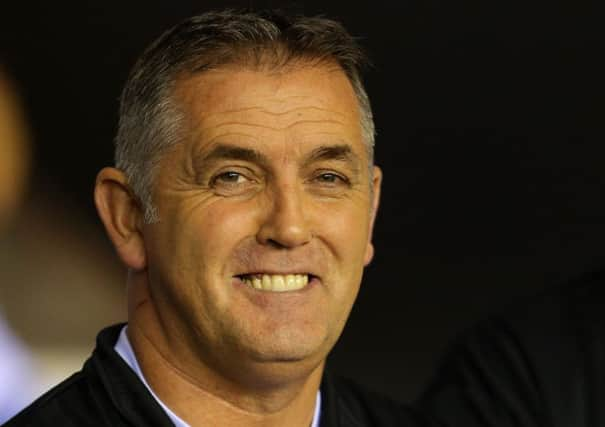The reigns of Dyche and Coyle are incomparable!


Many of the world’s most pressing and paramount conundrums - like those above - often leave us stumped for answers. But it was a spontaneous scenario posed by the panel of NoNayNever.Net that forced me to reach for pen and paper in a bid to resolve my own inquisition.
The question? From Owen Coyle’s promotion-winning squad of 2008/09 and Sean Dyche’s current crop of players, what would be your starting XI? I think I ended up naming enough players for an entire squad.
Advertisement
Hide AdAdvertisement
Hide AdHowever, after moments of deliberation and indecision I acknowledged that there was a fundamental reason for my struggle. There were significant differences between the formations and tactics of the respective sides that had been specifically tailored to suit the style and personnel of those squads.
For instance, Coyle’s set-up was unpredictable as he flitted between 4-2-3-1, packed the midfield in a strict 4-5-1, put the impetus on committing men forward in a 4-1-3-2, utilised a rigid 4-4-2 while ending the season with the successful 4-1-4-1 formation that was prevalent throughout the play-off venture. The Scot was experimental to say the least.
But the beauty of Coyle’s compendious squad was that it catered for inconsistency in tactical models and selection. Though it may sound like jargon from a coaching manuel, the various dimensions within the squad made it possible to develop variations of more elemental structures.
Injuries and suspensions would sometimes force his hand, but even with the smallest squad in the division he’d often fluctuate. On occasions he’d opt for the zip and precision of Joey Gudjonsson in the middle, sometimes it would be the composure and coolness of Kevin McDonald though the talismanic Graham Alexander and Chris McCann were ever presents in his selection.
Advertisement
Hide AdAdvertisement
Hide AdThen there was the invention, drive and flair that the team was reliant and built upon. That came in the form of Chris Eagles, Robbie Blake and Wade Elliott, whether used as wide outlets, or in an advanced role among a three behind the striker to compliment the pace and tenacity of Martin Paterson. And then there’s Steven Thompson who would be employed as a target man when a more direct route was required.
The Scot’s tenure was one based on belief, desire and an imperishable winning mentality. At times it was gung-ho, driving at the opposition. While the leadership qualities of Alexander and skipper Steven Caldwell counteracted a relative lack of organisation, the Clarets worked on the philosophy that they would simply out-score their opponents to win games in contrast to building from the back.
When looking at the statistics from the league campaign, goals and assists came from all areas. Alexander contributed with nine goals, mainly from the spot, and two assists. Gudjonsson scored six times and added two assists; Paterson contributed with 12 goals and five assists; Wade Elliott notched four times with 10 assists; Chris McCann scored six times with four assists; Blake found the net eight times and assisted his team-mates on 11 occasions; Thompson scored seven and assisted twice while Eagles added eight goals and seven assists.
The framework under Coyle only genuinely came to fruition at the end of the campaign when the Clarets kept five clean sheets in six outings, while scoring 11 times.
Advertisement
Hide AdAdvertisement
Hide AdIn contrast there’s Dyche’s footballing philosophy, one of work-rate, endeavour, organisation, balance and precision. Dyche has formulated a structure, a methodical framework that has ultimately bred consistency.
Burnley’s energy and endurance has been unrivalled to date this season. A ruthless defensive five - with nine clean sheets in all competitions - has provided the ideal foundation but it’s been accentuated by the desire of every other player to get behind the ball when attacks break down.
While Coyle had craft, Dyche has graft as well as invention. The energy and willingness to cover ground of Dean Marney and the vision and distribution of David Jones has proven to be the perfect marriage in the centre of the park.
Rather than drive, the focus has been on prising teams open with intricate, one-touch moves, and infiltrating the space in-behind defenders and full-backs. It’s about pressing high up the field, nicking possession on the halfway line and springing attacks with the opposition exposed. We’ve seen it happen on numerous occasions with David Edgar robbing an unsuspecting Richie Wellens in midfield before finding Kieran Trippier for Burnley’s second against Doncaster Rovers at the Keepmoat Stadium. Dean Marney stole possession from Karl Henry before the ball was worked in behind Richard Dunne to Danny Ings via a one-two with Sam Vokes to enable the striker to fire beyond Robert Green. And it happened against Millwall at The Den when Edgar pipped Shaun Derry to the ball, allowing Ings to spring the attack before Michael Kightly forced the equaliser.
Advertisement
Hide AdAdvertisement
Hide AdIt’s a fine balance but so far it’s one that’s paying dividends. Though the bulk of the goals have come from the forward two - who have a combined tally of 23 - it’s the shape of the side that has led to the Clarets boasting the best goal difference in the division with 17.
So when trying to pick between the two squads, the varying components may not suit. While Juan Mata may not fit in to Jose Mourinho’s plans at Chelsea, similarly the likes of Blake and Eagles would struggle to fit the mould under Dyche. On the flip side, Arfield’s work rate probably wouldn’t suit Coyle’s style.
It’s not just about choosing an XI, it’s also about who’ll be the one operating from the sidelines.